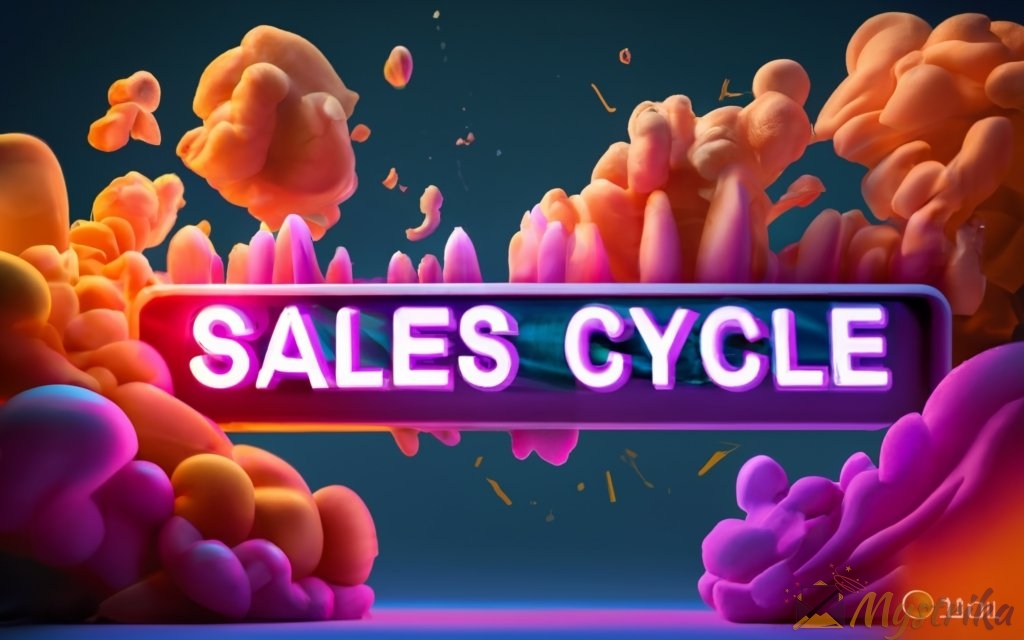For companies seeking revenue growth, mastering the art of selling is mandatory. But often, sales activities seem disconnected rather than part of a repeatable blueprint. Enter the sales cycle – a phased journey to methodically convert prospects into delighted customers.
This comprehensive guide explores each sales cycle stage, plus tips to optimize your workflow for results. Follow along to transform your strategy.
What is the Sales Cycle and Why is it Important?
When it comes to sales, the sales cycle refers to the journey a prospective buyer takes from initially becoming aware of a product to ultimately making a purchase. It encompasses every touchpoint and interaction that occurs along the way. While the exact steps may vary across businesses, the sales cycle generally follows a predictable path through 7 key stages.
So why is understanding and optimizing your sales cycle so crucial for success? Let’s break it down.
Defining the Sales Cycle
The sales cycle consists of every step a potential customer goes through in their buying journey, starting from the initial prospecting stage to closing the deal. It provides a roadmap that guides your sales processes and techniques at each phase to move leads closer to a purchase.
Here are the 7 core stages that make up a typical sales cycle:
- Lead Generation
- Lead Qualification
- Initial Contact
- Presentation/Addressing Objections
- Lead Nurturing
- Closing the Sale
- Referrals/Repeat Sales
However, it’s important to note that while these 7 stages are common, the specific steps may vary across businesses based on factors like:
- Type of product/service
- Complexity of sale
- Number of decision makers involved
- Industry standards and norms
For example, a B2B sale of enterprise software may have a longer, more complex sales cycle than a B2C transactional sale. The steps will need to be adapted accordingly.
The 7 Key Stages of the Sales Cycle
Let’s look at what comprises each of the 7 stages in more detail:
Stage 1: Lead Generation
This initial prospecting phase focuses on identifying and targeting potential customers who may be interested in your offering. Sales teams research their ideal buyer profiles and leverage tools like digital ads, events, referrals, cold calling, and more to build a strong lead list.
Stage 2: Lead Qualification
Not every lead is ready to buy from you. Lead qualification helps sales teams determine which prospects are more “sales qualified” based on criteria like need, budget, authority, and buying timeframe. This enables more efficient allocation of resources.
Stage 3: Initial Contact
Once promising leads are identified, sales reps reach out to them for the first time, often via email or phone. The goal here is to introduce themselves, start building rapport, and get prospects excited about a meeting.
Stage 4: Presentation/Address Objections
During an in-person meeting or sales presentation, reps explain their offering in-depth, highlighting benefits tailored to that particular customer. They also aim to address any concerns or objections raised at this stage.
Stage 5: Lead Nurturing
Additional follow-ups and continued communication after the presentation helps further build trust and affinity. Content, emails, and social media keep your brand top-of-mind.
Stage 6: Closing the Sale
At this critical stage, sales reps ask for the business and finalize the purchase. Negotiating contracts, pricing, and details happens here.
Stage 7: Referrals/Repeat Sales
Happy customers can become brand advocates, providing referrals for new leads. Ongoing sales relationships lead to repeat business down the line.
The Importance of the Sales Cycle
Optimizing your sales cycle pays big dividends across these key areas:
- Better Lead Conversion Rates – Data shows companies with defined sales cycles convert 6x more leads into customers.
- Increased Sales Team Productivity – A structured sales process reduces inefficiencies and helps reps close more deals faster.
- Higher Revenue Growth – Organizations with formal sales cycles achieve 15% faster revenue growth on average.
- Enhanced Customer Relationships – Aligned sales processes improve communication and nurturing, leading to happier repeat buyers.
- More Accurate Sales Forecasting – Analyzing sales cycle metrics enables more precise predictions of upcoming sales.
- Effective Training for Sales Reps – New hires get up to speed faster by following a proven step-by-step roadmap.
- Identifying Areas for Improvement – Tracking sales cycle KPIs uncovers issues and opportunities to optimize.
- Facilitating Marketing/Sales Alignment – Shared sales cycle visibility promotes collaboration between teams.
Without a well-defined sales cycle, your revenue growth and sales productivity will lag. But by taking the time to map out and refine each step of your process, you gain a blueprint for sales excellence.
For example, examine the typical length of your sales cycle. If it’s 60 days on average but your competitors close deals in 30 days, you can analyze where delays happen and devise improvements.
Whether you need to ramp up lead nurturing, provide sales staff with better tech tools, or simplify your contracts, a data-driven sales cycle perspective highlights problems.
Similarly, tracking conversion rates at each stage reveals where leads are falling out of your funnel so you can plug those leaks. The power of the sales cycle lies in understanding the customer’s journey to remove friction and smoothen each touchpoint.
While the sales process itself may differ across organizations, taking a strategic approach is universally valuable. Even small optimizations like email templates and call scripts designed for specific sales stages can make a significant impact.
Adapting your cycle to mirror industry benchmarks is also smart. If top firms spend more time on product demos, you may need to extend your presentations. If competitors send 5 follow-up emails over 2 weeks, assess if your lead nurturing matches up.
For any business seeking to boost sales, implementing a structured sales cycle tailored to their audience, offerings, and team strengths provides a foundational advantage.
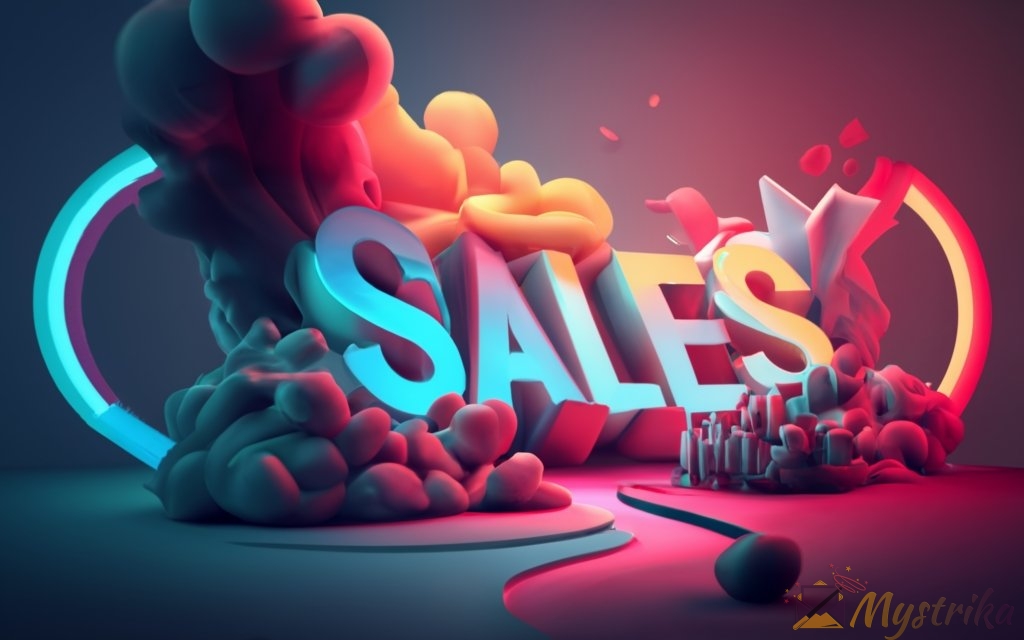
Comparing B2B and B2C Sales Cycles
While all sales cycles share common stages, significant differences exist between B2B (business-to-business) and B2C (business-to-consumer) cycles. Understanding these nuances is key to tailoring strategy accordingly.
Let’s break down how B2B and B2C sales cycles vary:
The B2B Sales Cycle
Selling to other businesses often entails a longer, more complex journey with multiple decision-makers and stakeholders.
Typical Length
- 3-6 months on average
- Can extend to 1 year+ for large contracts
Buying Process
- Involves multiple people with input
- Economic buyers who control budget
- Technical experts who evaluate needs
- End-users impacted by purchase
- Extensive research and comparison of solutions
- Formal procurement processes and rules
Sales Approach
- Consultative selling based on problem-solving
- Customized pitches highlighting ROI
- Relationship-building over long term
- Handling committees and consensus-based decisions
- Post-sale integration and support emphasis
- Thought leadership content like whitepapers
- Targeted digital ad campaigns with industry terminology
- Participating in trade shows and events
- Leveraging referrals and word-of-mouth
The B2C Sales Cycle
B2C sales to individual consumers tend to happen much quicker and are more emotionally driven.
Typical Length
- Hours to days in most cases
- 1-2 weeks on the longer end for big purchases
Buying Process
- Individuals making unilateral decisions
- Impulse purchases and emotional appeal factor highly
- Minimal research or comparisons
Sales Approach
- Transactional interactions
- Focus on convenience, quality, and prompt service
- Driving instant gratification and clear cost-benefit
- Eye-catching ads using aspirational messaging
- Promotional pricing like flash sales
- Leveraging social proof and influencer endorsements
- Emphasizing unique features of offering
Comparing Key Differences
| B2B | B2C | |
| Length of sales cycle | Longer (months/years) | Shorter (hours/days/weeks) |
| Buying process | Complex, multiple stakeholders | Individual decision-making |
| Key influencers | Logic, rational analysis | Emotions, impulse desires |
| Sales approach | Consultative, relationship-based | Transactional interactions |
| Marketing focus | Thought leadership, expertise | Aspirational, promotional messaging |
A B2B sales cycle has a longer runway by nature of the products, decision complexity, and purchaser differences. For a manufacturer buying factory equipment, stakeholder alignment, budget sourcing, and lengthy ROI projections elongate the process.
On the B2C side, individuals make faster judgments based on desire, affordability, and emotions. A shopper buying cosmetics compares far less and acts on personal preferences.
These dynamics mandate divergent sales and marketing strategies as well. B2B prioritizes nurturing long-term relationships, starting from the early stages when scoping pain points and needs. Relevant content and subject authority establish credibility.
B2C interactions are more transactional, relying on enticing messaging, attractive pricing, and impulse sparking. The beginning of the sales cycle centers on grabbing attention quickly before consumers move on.
Beyond the customer journey, the sales team composition also differs significantly between B2B and B2C organizations.
B2B Sales Team
- Sales engineers to demonstrate technical product fit
- Pre-sales consultants for complex vetting and trials
- Account executives to manage client relationships
- Sales support staff to assist with proposals and quoting
B2C Sales Team
- Strong UI/UX designers to optimize web/mobile experience
- Customer support staff to manage questions/complaints
- Telesales people to convert inbound leads swiftly
- Brand ambassadors on social media for engaging audiences
Ensuring sales and marketing personnel have B2B or B2C appropriate skills is vital. Reps adept at explaining highly complex software capabilities get lost selling simple self-serve products online. And staff accustomed to one-and-done retail transactions may never close elaborate enterprise deals.
Adapting Your Sales Cycle
The more your sales cycle aligns to the norms, expectations, and best practices of either B2B or B2C selling, the better your results will be.
For B2B companies, exhaustively map the decision-making roles, processes, and timeframes your clients face. Identify key events like budget planning or technology review meetings you can sync with.
In B2C, obsess over understanding your customer demographics, motivations, and emotional triggers. Fine tune funnels and user experiences toward impulse satisfaction and minimum hassle.
While no business exists purely in the B2B or B2C realm, analyzing where you mostly operate is crucial. Isolate those high impact characteristic differences between each cycle model above.
Then scrutinize every sales, marketing, analytics, and support element of your organization for opportunities to optimize for your core customer type. Incremental improvements add up, creating compounding benefits over the long term.
By taking the time to discern the unique complexities of business-to-business versus business-to-consumer sales cycles, you gain an invaluable advantage. Sales processes mistakenly treated identical despite divergent realities leave money on the table and constrain growth.
Leverage your knowledge of how these cycles differ to rise above competitors who just use a one-size-fits-all approach.

Essential Sales Tools and Software
While the fundamentals of selling remain constant, technology has opened up game-changing possibilities for optimizing every phase of the sales cycle. The right tools remove repetitive manual work, enhance communication, provide key insights, and increase overall sales productivity.
Let’s explore some of the most impactful sales software and tools that modern organizations are leveraging:
CRM Platforms
Customer relationship management (CRM) systems form the core of most sales technology stacks today. They provide a centralized database for capturing and managing all prospect and customer information in one place.
Key features include:
- Contact management
- Pipeline tracking
- Lead scoring
- Opportunity tracking
- Sales forecasting
- Reporting and analytics
CRM benefits like 360-degree customer views, automated workflow triggers, and sales performance dashboards directly accelerate the sales cycle. Salespeople save hours previously spent on manual data entry and organization.
Popular CRM options include:
- Salesforce
- HubSpot
- Zoho CRM
- Pipedrive
- Freshsales
Marketing Automation Software
Where CRM focuses on sales tracking and management, marketing automation handles multi-channel lead nurturing at scale. These tools send prospects timely and relevant content like emails, social messages, and texts based on their sales cycle stage and activity.
Marketing automation provides:
- Email templates by sales stage
- Lead scoring rules
- Web tracking and analytics
- Landing page creation
- Multi-step campaigns
- ROI reporting
This technology allows personalized, automated lead nurturing 24/7. Together with CRM, it provides comprehensive visibility from lead generation to closed deal.
Top marketing automation platforms:
- Mystrika, for Outbound lead generation using Cold Email (and Email Warmup)
- HubSpot
- Marketo
- Pardot
- Ontraport
- ActiveCampaign
Call Center Software
Call centers remain a popular tactic for qualifying inbound leads swiftly. Cloud-based call center software equips sales reps with the capabilities to handle high call volumes efficiently.
Capabilities include:
- Automatic call distribution
- IVR menus and routing
- Call recording
- Call analytics
- Agent performance dashboards
- SMS integration
By automatically disseminating calls, providing helpful prompts, and tracking agent KPIs, this software optimizes early-stage lead qualification.
Leading options include:
- Five9
- RingCentral
- Talkdesk
- Genesys
- Nice InContact
Data and Analytics Platforms
Harnessing the power of data is a sales game-changer. Analytics platforms ingest customer information from sources like web, CRM, marketing automation, and more to uncover optimization opportunities.
Key analytics features:
- Lead origin analysis
- Sales performance trends
- Pipeline health indicators
- Win/loss evaluation
- Forecasting projections
- KPI dashboards
Armed with actionable intelligence, sales leaders can pinpoint inefficient processes, assess rep performance, benchmark metrics, and justify smart investments.
Top analytics tools:
- Salesforce Einstein
- Google Analytics
- Mixpanel
- Klipfolio
- Sisense
Additional Sales Tools
Beyond the platforms above, a few other technologies worth considering include:
Proposal Software
Templates, automation, and analytics streamline creating and tracking client quotes and proposals. Examples: PandaDoc, Qwilr, QuoteRoller.
Email Tracking
Sales emails tracked for open/click activity provide engagement insights. Examples: Mixmax, Mailtrack, Cirrus Insight.
Meeting Scheduling
Simplify booking sales calls and meetings with integrated calendar systems. Examples: Calendly, AcuityScheduling, YouCanBookMe.
Document Management
Centrally storing and accessing contracts, playbooks, collateral. Examples: Box, OneDrive, Dropbox.
VoIP Calling
Cloud phone systems like Zoom enable low-cost sales calls. Examples: RingCentral, Nextiva, 8×8.
Sales Coaching Software
Tools for recording sales calls, sharing best practices, and one-on-one mentorship. Examples: Gong, Chorus.ai, SalesLoft.
Key Selection Criteria
With so many sales tools out there now, focus on these factors when evaluating options:
- Ease of use – Will reps actually use it daily? Is the learning curve reasonable?
- Mobility – Are key features available on mobile devices?
- Integration – Does the software connect with your current tech stack?
- Cost – Do the productivity benefits outweigh licensing costs?
- Data security – Does the vendor offer robust data protection?
- Scalability – Can the platform support your growth trajectories?
- Customer support – Is training and technical assistance readily available?
Getting Started
When investigating sales software:
- Involve both sales and IT teams for balanced perspective
- Assess current pain points and objective requirements
- Analyze workloads to right-size capabilities
- Read independent software reviews for impartial insight
- Take advantage of free trials to test drive options firsthand
Jumping right to a complete suite like Salesforce or HubSpot may seem tempting for comprehensive coverage. But implementing too much new technology simultaneously can backfire.
Instead, consider stepping up your sales stack gradually. Start with foundational CRM, then layer on marketing automation and analytics capabilities over time. This measured approach allows proper training and adoption while showcasing ROI for further tool investment.
And don’t forget that even the most cutting-edge software depends on people using it properly. Provide ample onboarding and ongoing training to extract the full value from your sales technology.
Gone are the days when sales teams could get by with just phones and legal pads. In the modern era, embracing sales software unlocks game-changing efficiency. The key is selecting the right mix of tools tailored to your specific sales process needs and team culture.
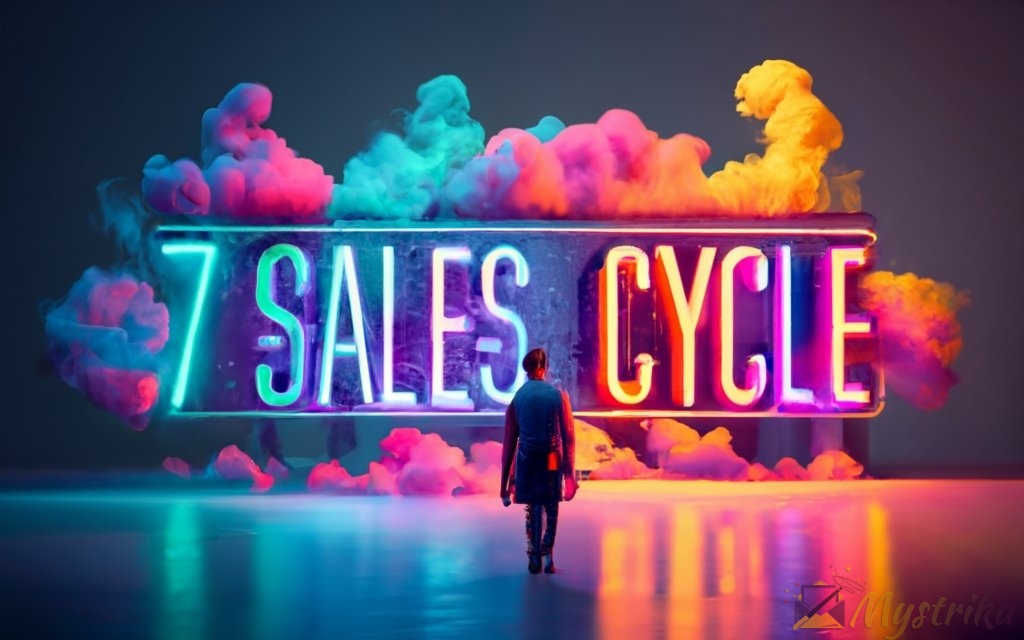
The 7 Key Stages of the Sales Cycle
Now that we’ve covered sales cycle fundamentals, let’s dive into the 7 core stages that comprise most sales processes.
Understanding these phases from lead to customer empowers you to map strategy and messaging appropriately across the customer journey.
Stage 1: Lead Generation
Lead generation represents that crucial first step – identifying and targeting potential customers. This initial prospecting phase involves:
Building a Lead List
Populating your sales pipeline starts with research to build a robust lead list.
- Persona research – Determine your ideal customer profile based on attributes like demographics, challenges, and goals.
- Database searching – Leverage tools like LinkedIn Sales Navigator to find prospects matching your criteria.
- Events – Attend or sponsor relevant industry conferences and seminars to connect with prospects.
- Referrals – Existing customers and partners can provide qualified referrals.
- Ads – PPC, social media, and retargeting ads help connect with potential buyers.
- Inbound marketing – Content, SEO, and lead magnets attract visitors to convert into leads.
Expanding Contact Points
Cast a wide net identifying prospects across multiple channels:
- Website and landing pages
- Cold calling and emails
- Social media engagement
- Physical mailings and fliers
Monitoring Market Problems
Keep prospecting efforts aligned to current buyer needs by continually researching market challenges ideal for your offering.
Leveraging Available Data
Information sources like web analytics, VOC surveys, and win/loss analysis help focus prospecting where interest is highest.
With a robust lead generation approach, your sales pipeline stays flushed with fresh contacts to pursue new deals.
Stage 2: Lead Qualification
Not every lead is a fit for your solution. The qualification process assesses generated leads to determine sales readiness.
Scoring Leads
Lead scoring models rate prospects based on criteria like:
- Recency/frequency of activity
- Pages visited
- Form fills/downloads
- Email opens/clicks
- Match to customer profile
Higher scored leads warrant prioritized follow-up, while low scores signal leads to nurture or discard.
Sales Calls/Questionnaires
Sales team members personally engage with leads to gauge interest level. Key qualifying questions determine:
- Budget – Can they afford your offering?
- Authority – Are they the decision maker?
- Need – Do they have a compelling problem to solve?
- Timeline – What is their purchase timeframe?
Routing to Reps
Marketing teams route qualified, sales-ready leads to account executives or sales development reps for further nurturing toward deals.
Stage 3: Initial Contact
With promising leads identified, your salespeople now initiate first contact to introduce themselves and your brand.
Personalized Outreach
- Emails and LinkedIn messages make that first critical impression. Personalize each message after researching the prospect’s role, company, and interests.
- Follow-up calls let reps establish rapport through two-way conversation.
Seeking Appointments
Initial contacts prime prospects for next steps. Seek to schedule:
- A product demo to showcase your solution.
- An in-person meeting to begin building the relationship.
- A discovery call to explore their unique needs.
Driving Excitement
- Highlight relevant customer success stories to pique their interest.
- Provide previews of your value proposition.
- Convey understanding of their market landscape and challenges.
- Leverage any existing connections for a warm introduction.
Stage 4: Product Presentation and Addressing Objections
Here the rubber meets the road. Now the prospect gets a detailed overview of your offering and how it solves their needs.
Introducing the Product
The presentation should focus on:
- Explaining product/service capabilities and features
- Tailoring the value proposition to that particular prospect
- Providing demo walkthroughs specific to the customer’s use cases
- Conveying your suitability versus competitors
Uncovering Concerns
Welcome objections! Use the presentation as an opportunity to uncover and address any reservations or concerns.
- Listen carefully to understand context behind objections.
- Offer helpful educational materials to resolve knowledge gaps.
- Provide reassurance regarding common obstacles like implementation, change, or new workflows.
- Convey advantages over current solutions prospect relies on.
- Stress availability of stellar customer support.
Proposing Next Steps
Close the presentation by proposing logical next actions:
- Providing product trial access
- Arranging user interviews with current clients
- Proposing statement of work or contract for deal moving forward
Stage 5: Lead Nurturing
After the product presentation, you still have lots of work ahead to continue nurturing the prospect forward.
Ongoing Communication
Regular communication after the presentation prevents leads from dropping off.
- Send nurturing email sequences covering common customer questions.
- Provide relevant educational materials like ebooks, tip sheets, and videos.
- Schedule follow-up calls to reinforce key points and next steps.
- Engage via social media by commenting on updates, sharing content.
Addressing Concerns
Prospects often require multiple exposures over time before feeling comfortable. Continue addressing doubts by:
- Connecting users with current customers to share experiences.
- Offering favorable payment terms or expanded trials to reduce perceived risk.
- Providing benchmarks, stats, and reassurance regarding obstacles.
Relationship Building
Turn prospects into evangelists by forging personal connections:
- Discuss professional backgrounds and interests beyond just business needs.
- Offer industry insights and advice tailored to their role.
- Attend networking events and conferences they participate in.
- Look for opportunities to provide value without expectation.
Stage 6: Closing the Sale
Time to get the deal across the finish line! The sales close is the crescendo that all previous stages build toward.
Negotiating Details
- Address any last concerns about pricing, contract terms, implementation, integrations, or responsibilities.
- Be prepared to provide discounts or value-adds like premium support if needed to seal the deal.
- Involve company leadership contacts if necessary to finalize high-value deals.
Completing Paperwork
- Supply necessary legal paperwork like contracts, statements of work, and service agreements for approval.
- Ensure appropriate stakeholders within the prospect organization formally sign off.
- Collect payment information and validate billing details.
Onboarding
- Congratulate the new customer and assure them of your commitment to their success.
- Expedite delivery of any materials provided like user setup guides or administrator tools.
- Introduce key contacts and advisors who will guide onboarding.
Stage 7: Referrals and Repeat Sales
Your job doesn’t end once the contract is signed. Maximize customer lifetime value with referrals and upsells.
Getting Referrals
Satisfied clients make excellent brand evangelists:
- Ask satisfied clients directly if they know others who could benefit from your solution.
- Provide incentives for referrals like discounts or premium services.
- Request testimonials and case studies you can share publicly to attract similar prospects.
Facilitating Upsells
Grow the account by proactively proposing:
- Expanded capabilities and premium offerings for increased adoption.
- Additional licenses or seats as customer usage grows.
- Complimentary solutions you offer to fulfill a broader range of needs.
Ensuring Retention
Keep customers happy and prevent churn by:
- Checking in regularly to address any concerns preemptively.
- Surveying users to monitor satisfaction and head off problems.
- Celebrating milestones and anniversaries to reinforce the relationship.
- Providing access to an online customer community for connecting with peers.
The sales cycle rarely follows a perfectly linear progression. But thoroughly understanding these 7 fundamental stages gives you a strategic advantage in guiding prospects ultimately to become delighted, lifelong customers.
Review your current sales workflows against this sales cycle framework. Look for potential enhancements at each phase that better facilitate progress from one stage to the next.
Even minor incremental improvements have a cumulative effect over time as win rates increase, lengths compress, and efficiencies ramp up. Investing in sales cycle excellence generates a high ROI in customer acquisition and lifetime value.

Optimizing Your Sales Cycle
Even well-oiled sales machines need tune-ups. Regularly optimizing your sales cycle accelerates deals, increases conversion rates, and maximizes revenue.
Let’s explore key ways to analyze and enhance your sales process.
Improving Lead Generation
Robust lead generation feeds your pipeline. Try these tactics:
- Expand prospecting channels – Advertise in new markets. Join relevant associations and networks. Attend competitor events.
- Refine targeting – Analyze your wins to identify your ideal customer profile attributes. Focus efforts on matches.
- Boost SEO – Optimize website content for search visibility around targeted buyer keywords.
- Automate follow-ups – Software immediately engages new contacts to build relationships.
- Offer incentives – Lead magnet gated offers entice visitors to convert through forms.
Shortening Sales Cycle Length
Lengthy sales cycles drag down productivity. Strategies to accelerate include:
- Set expectations upfront – Convey typical process timeframes so buyers understand.
- Highlight value quickly – Explain key differentiators early to build enthusiasm.
- Limit sales stages/steps – Remove any redundant or unnecessary steps adding delays.
- Standardize pricing – Simplify quoting with predefined options vs fully custom every time.
- Automate workflow – Triggers and reminders ensure no stalled steps.
- Incentivize urgency – Discounts or bonuses for fast decisions motivate action.
Leveraging CRM and Automation
Sophisticated tools optimize every facet:
- Lead scoring – Identify hottest prospects using scoring algorithms.
- Email templates – Craft messages tailored to sales stage.
- Workflow design – Model ideal sequencing and timing for nurturing.
- Analytics – Uncover patterns for refining strategies based on hard data.
- Performance tracking – Ensure accountability with rep metrics monitoring.
Strengthening Lead Qualification
Tighter qualification improves sales resource efficiency:
- Define criteria – Agree on key traits of ideal prospects beyond just interest.
- Lead rating methodology – Weight factors like budget, need, and timeline for consistent scoring.
- Assess tools – Quizzes, predictive lead scoring software.
- Sales call probing – Train reps to deeply qualify beyond surface inquiries.
- Automated filtering – Route leads automatically based on activity and profile.
Boosting Marketing/Sales Collaboration
Aligned goals and processes between marketing and sales prevent handoff issues:
- Shared KPIs – Compensation incentives tied to joint metrics like revenue and customer retention.
- Clear buyer journey mapping – Illustrate exactly how leads flow between teams and systems.
- Open communication – Set expectations, give feedback, address pain points together.
- Coordinated tools – Integrate CRM and marketing automation into seamless handoffs.
- Service level agreements – Define quantitative lead qualifications and response times formally.
Improving Lead Nurturing
More effective nurturing converts more prospects:
- Targeted content – Tailor emails, offers, webpages to buyer stage and interests.
- Omnichannel strategies – Orchestrate seamless messaging across channels.
- Hyper-personalization – Leverage data insights to craft resonating 1:1 communication.
- Persistence – Follow up regularly until lead indicates disinterest.
- Monitoring engagement – Track email opens, form fills, web activity to gauge interest level.
Analyzing Metrics and Trends
Crunching numbers identifies areas needing improvement:
- CRM data analysis – Evaluate key performance indicators by rep, product line, channel, geography, deal size, etc.
- Customer surveys – Solicit feedback on satisfaction, pain points, and suggestions.
- Win/loss research – Review why you win vs. lose deals through questionnaires and interviews.
- Buyer journey mapping – Identify common drop-off points across the stages.
- Churn analysis – Assess defection causes and patterns.
Testing and Experimentation
Incremental optimizations through disciplined testing generates continual enhancements:
- A/B test – Try variations of webpages, offers, pricing, messaging to determine what resonates best.
- Sales onboarding – Try different sales rep training programs and approaches.
- Channel ROI – Test new channels, get cost-per-lead data, double down on most profitable ones.
Adapting to Change
Keep processes aligned with evolving market dynamics:
- Evaluate new tech – Cloud, mobility, AI offer new capabilities to leverage.
- Ongoing training – Update teams on best practices, competitive intel, and trends.
- Flexible forecasting – Adjust projections frequently based on metrics and macro environment.
- Refreshed personas – Revalidate assumptions about your ideal buyer as their needs shift.
Just because a sales process has worked well doesn’t mean it can’t be improved. Regularly inspect every facet of your sales cycle for ways to tweak and optimize. Tiny enhancements compound over the long run.
Leverage the ideas presented here as stimuli to spark your own innovative thinking. Even long-established sales organizations need to stay nimble and open to trying new approaches.
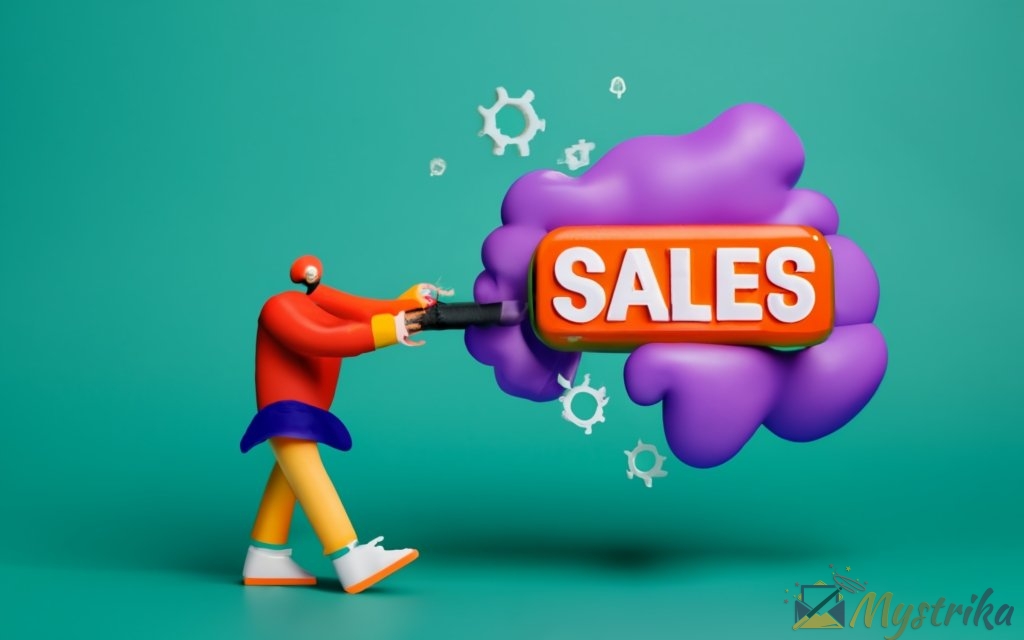
Implementing Best Practices for Sales Cycle Success
What separates the good from the great when it comes to sales cycle execution? Adopting these best practices sets you on the path to sales excellence.
Clearly Defining Sales Stages and Steps
Ensure your sales process is documented in detail. This facilitates:
- Consistent execution – Less variance when each rep follows the same mapped workflow.
- Training efficiency – Onboarding new hires is accelerated with a proven blueprint.
- Identifying gaps – Missing phases become obvious when mapping the linear progression.
- Optimizing pacing – Analyze timing between steps to shorten overall cycle length.
- Clear role clarity – Defines handoffs between marketing and sales.
Ideally, document the following specifics:
- Description of each step’s goal
- Recommended activities and tasks
- Target timeframes and durations
- Decision gates and qualifications to proceed
- Defined responsibilities – who does what
- Related systems, templates, and tools
Monitoring Key Performance Indicators
Sales cycle KPIs provide objective measures of effectiveness. Common metrics include:
- Sales cycle length – Average number of days from open to close
- Win rate – Percentage of proposals that convert into sales
- Lead conversion rate – Percentage of leads that become pipeline opportunities
- Sales revenue attainment – Actual sales achieved against goals
- Lead response times – How quickly leads are contacted
- Activity metrics – Calls made, emails sent, touches per lead
- Customer acquisition costs – Costs to generate a new customer
- Customer lifetime value – Revenue per customer over the long term
Structuring Your Sales Team Strategically
Balance structure and specialization across roles for optimal performance:
- Sales reps – Generalists managing a book of accounts end-to-end
- Lead qualifiers – Quickly vet inbound leads and route appropriately
- Sales development – Nurture marketing qualified leads into sales qualified
- Account executives – Manage and grow key strategic accounts
- Sales engineers – Provide in-depth technical guidance
- Sales enablement – Develop content, tools, and training to bolster selling skills
Proactive Performance Management
- Individual goals and objectives – Align to sales cycle KPIs.
- Pipeline reviews – Regular deal status check-ins.
- Skills assessments – Identify development areas.
- Call monitoring – Listen in for coaching and best practice sharing.
- Sales contests – Friendly competition drives activity.
- Awards – Publicly recognize achievements.
Tracking Pain Points for Optimization
Uncovering sales cycle friction points illuminates improvement opportunities:
- CRM data analysis – Review performance trends by rep, product, customer type, etc. to isolate underperformance.
- Process auditing – Examine sales collateral, info access, administrative workflows.
- Sales team surveys – Solicit honest feedback on bottlenecks.
- Customer research – Probe on satisfaction, areas for enhancement.
- Win/loss reviews – Determine why you win or lose deals. Look for patterns.
Maintaining Organized Records
Complete sales data is a prerequisite for excellence:
- Central CRM system – All prospect and customer information in one place.
- Defined fields – Standard terminologies between reps.
- Activity logging – Call summaries, meeting notes, follow-ups.
- Effective search – Easily retrieve records.
- Information security – Control internal access and maintain external confidentiality.
- Collaboration – Sales and marketing teams access relevant shared data.
Cultivating a Learning Environment
Top performers never rest on past achievements. They:
- Attend conferences – Stay on top of industry trends and innovations.
- Read blogs and newsletters – Continual enrichment from thought leaders.
- Participate in associations – Connect with peers and experts.
- Study competitors – Don’t become complacent.
- Solicit client feedback – Voice of the customer steers improvement.
- Advance skills – Pursue professional development through courses, certification, and training.
Investing in Sales Technology
Sophisticated tools propel productivity:
- CRM – Centralized database with key customer insights.
- Marketing automation – Scales lead nurturing across channels.
- Data and analytics – Uncovers optimization opportunities.
- Proposal and quote systems – Streamline creation and tracking.
Don’t leave sales technology investments purely to IT. Engage sales leaders to ensure user adoption and optimal workflows.
Maintaining Realistic Projections
Accuracy demands regularly calibrated forecasts based on:
- Historic metrics – Use past performance as a baseline for modeling.
- Trend analysis – Account for seasonality, market dynamics, competitive forces.
- Pipeline health – Weigh quality of current open opportunities.
- Economic climate – Macro-economic factors impact sales cycles.
Building Trusted Relationships
At its heart, sales remains a people business.
- Listen intently – Grasping needs takes understanding.
- Share experiences – Tell stories, don’t just pitch.
- Convey empathy – You can’t fake caring about someone’s problems.
- Focus on value – Prospects want help, not products.
- Embrace mentorship – Lift up others and they’ll return the favor.
Following these keys to sales cycle success establishes your foundation. But never become complacent. Tomorrow may bring new challenges, technologies, and competitors. Like a championship sports team, continued achievement demands commitment, collaboration, analysis, and practice.
By instilling best practices into your sales DNA, you equip yourself to execute at the highest levels consistently, which is the only path to sustained sales leadership.

Adapting Your Sales Cycle by Industry and Business Type
One size does not fit all when it comes to sales cycles. Smart companies analyze their unique business landscape and tailor their sales process accordingly.
Tailoring Your Cycle for B2B vs. B2C
As we’ve discussed previously, fundamental differences exist between business-to-business and business-to-consumer sales cycles.
B2B Adaptations
- Extended cycles to account for complex buyer committees
- Consultative selling approach focused on ROI
- Sales engineers to demonstrate technical product fit
- Pre-sales consultations to scope intricate requirements
- Account management teams for strategic customer stewardship
- Targeted outreach conveying deep industry expertise
B2C Adaptations
- Shorter cycles given faster individual purchase decisions
- Transactional selling focused on simplicity, cost, and convenience
- Strong self-serve ecommerce funnel nurturing buyers through journey
- Social proof like testimonials to provide confidence
- Flash sales, promotions, and urgency tactics to spur action
- Marketing centered around aspirational and emotional messaging
Adjusting Based on Product/Service Specifics
Your offerings dictate sales process customization in multiple ways:
- Big-ticket purchases – Longer decision cycles requiring extensive research and consensus building.
- Mission critical solutions – Comprehensive pre-sales technical vetting and trials.
- Commoditized products – Focus on convenience, availability, and price competition.
- Custom/configurable offerings – Consultation to spec out specialized solutions.
- After-sales servicing – Account management and retention processes.
Mirroring Your Industry Norms
Certain sales conventions exist across industries that customers expect.
- Long B2B sales cycles – IT, engineering, construction, industrial equipment.
- Short B2C cycles – Retail, ecommerce, consumer services, hospitality.
- Extensive trials – Enterprise software, medical devices.
- RFP processes – Government, education, banking, insurance.
Build timelines, approval steps, and buyer education moments into your workflow that align with established industry practices.
Accommodating Market Changes
Evolving customer preferences and competitive forces necessitate sales cycle flexibility.
- Adopt emerging channels – Live chat, social selling, self-serve ecommerce.
- Offer financing – Options like payment plans if cash flow is tight.
- Get contracts signed faster – Some industries now balk at long drawn-out paperwork.
- Reduce sales pressure – Increasingly, buyers want minimal interaction and more research time.
- Highlight security – Industries like financial services demand ironclad data protections and compliance.
Example: Software Company XYZ
XYZ sold $10k SaaS licenses to mid-market retailers. Despite strong demand, their sales cycles stretched to 6+ months as buyers sought extensive customization and balked at long contracts.
XYZ adapted by:
- Offering scaled pricing tiers with predefined configuration options vs. fully custom each time.
- Introducing monthly subscriptions vs. only 1-3 year terms.
- Limiting buyer touches to key demos and follow-ups to reduce friction.
Results:
- Sales cycle shortened to 2-3 months.
- Contract values increased by only requiring 1-month minimums.
- Win rates improved as deals closed faster.
Like XYZ, routinely assess your cycle against your market realities. Even segments of your customer base may necessitate tailored sales processes that increase relevance and accelerate mutual success.

The Evolving Sales Cycle Landscape
The sales cycle of tomorrow looks quite different than yesterday. Savvy businesses stay on top of emerging trends and technologies to remain competitive.
Leveraging AI-Powered Sales Tools
Artificial intelligence drives sales growth through:
- Predictive lead scoring – Machine learning models rate prospects based on likely conversion.
- Intelligent email sequencing – AI tailors nurturing track based on engagement.
- Natural language processing – Chatbots qualify leads and surface insights from conversations.
- Voice analytics – Identify areas of strength/weakness analyzing sales call recordings.
- Buyer sentiment analysis – Gauge how prospects really feel about your solution by scanning their language patterns.
- Data-driven recommendations – Platforms like Salesforce Einstein suggest best next actions in workflows.
Adoption is still early for many organizations. Focus on augmenting reps’ efforts vs. fully automating them away.
Omnichannel Sales Journeys
92% of buyers crave consistent experiences across channels. Strategies include:
- Unified CRM data – 360 customer views with engagement data from all touchpoints.
- Cross-channel continuity – Email nurture sequences link to tailored web landing pages.
- Integrated messaging – Text/chat conversations automatically logged into CRM records.
- Consistent branding – Recognizable visual identity across platforms.
With buyers spending more time self-educating online, orchestrating seamless handoffs between digital and human selling is essential.
Hyper-Personalized buyer Journeys
Sales cycles tailored to the individual cut through the noise. Tactics involve:
- Dynamic content – Webpage product recommendations match visitor attributes. Email content adapts based on past engagement.
- Intent monitoring – Track website browsing to address questions in real-time.
- Machine learning applied – Platforms learn your ideal customers’ behaviors to target similar profiles.
- Account-based approaches – Highly customized campaigns focused on targeted strategic accounts vs. broad outreach.
- Video at scale – Recording personalized video messages instead of just emails and calls.
Buyers desire a sales experience as unique as they are. Leveraging data and technology creates this customized feel through relevance and proactivity.
The Rise of Self-Service Buying
For simple purchases, many now prefer minimal sales interaction. Strategies include:
- Intuitive ecommerce – User-friendly self-serve catalog shopping.
- Frictionless payments – One-click checkout and seamless mobile transactions.
- Smart recommendations – Suggest complementary or next-purchase products algorithmically.
- User communities – Forums for customers to discuss and learn without contacting sales staff.
- Self-service support – FAQs, chatbots, and help resources empower independent buyers.
Reduce sales cycle involvement for smaller deals or add-ons. Focus high-touch selling on large, complex opportunities.
Tighter Sales and Marketing Alignment
To deliver coordinated experiences, sales and marketing teams must:
- Share goals and metrics – Unified KPIs incent cross-departmental collaboration.
- Develop joint strategies – Account-based marketing engages hot prospects the sales team passes over.
- Improve data accessibility – Marketing automation and CRM tool integration links campaign engagement with deal progress.
- Coordinate messaging – Sales collateral reflects brand identity and campaign spirit developed by marketing.
- Formalize SLAs – Define quantitatively each department’s sales cycle responsibilities for seamless handoffs.
Blurring departmental lines streamlines buying journeys and prevents prospects from falling between the cracks.
The Bottom Line
Today’s sales winners will be those quick to embrace change rather than clinging to traditional methods. From adopting bleeding-edge technologies to optimizing highly personalized omnichannel journeys, the sales cycle transformation has only just begun.
Analyze your workflows against the trends outlined here. Brainstorm areas most ripe for modernization in your own organization. While sales fundamentals are timeless, the strategies and tools of implementation require constant evolution. To remain competitive, companies must continue advancing how buying journeys are architected at every stage, leveraging data, AI, automation, and integration in a customer-centric symphony.
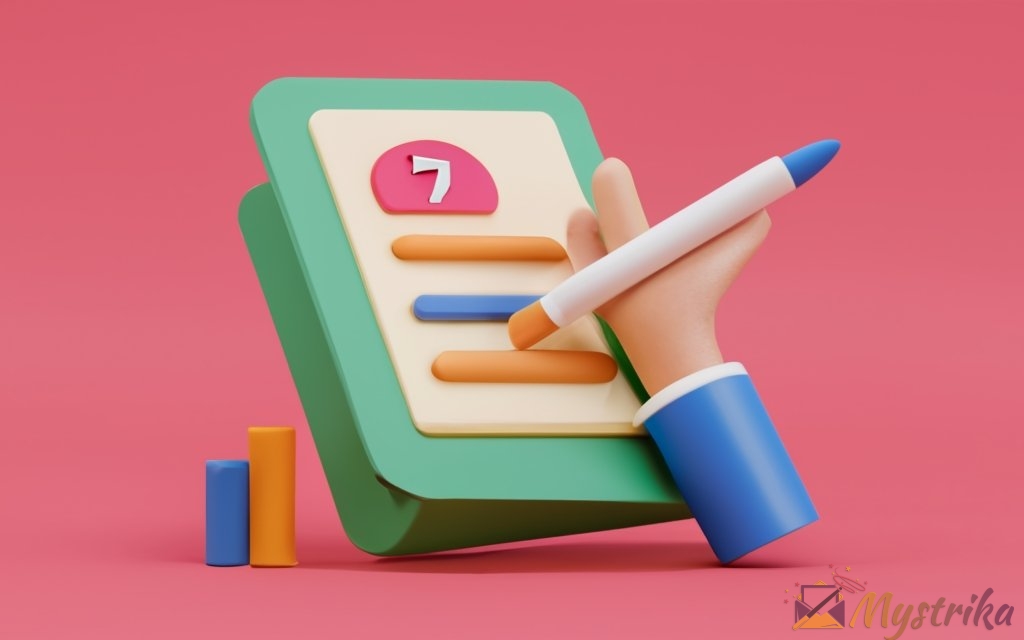
Conclusion and Key Takeaways
We’ve covered a lot of ground exploring the stages of the sales cycle and strategies to optimize the process. Let’s recap the core concepts.
What Is the Sales Cycle?
The sales cycle refers to the journey a prospect takes from initial awareness of your brand to becoming a customer. It provides a repeatable roadmap for marketing and sales teams to guide leads efficiently through key milestones that progress toward a purchase.
Understanding your specific sales cycle stages empowers you to map appropriate messaging and activities to steer customers along the path most effectively.
The 7 Stages of the Sales Cycle
While steps vary across businesses, common high-level phases are:
- Lead generation – Identifying potential buyers
- Lead qualification – Vetting lead viability
- Initial contact – Introducing your solution
- Presentation – Educating prospects on your value
- Lead nurturing – Ongoing engagement post-presentation
- Close – Finalizing the purchase
- Referrals – Getting customer referrals
Why Sales Cycle Optimization Matters
- Shortens cycle length to increase sales velocity
- Improves lead conversion rates
- Enables more accurate forecasting
- Identifies points of friction for improvement
- Allows tailored messaging for each buyer stage
- Facilitates better marketing and sales alignment
Tips for Sales Cycle Excellence
Ways to master your sales process include:
- Documenting your sales workflow in detail
- Monitoring key performance indicators
- Leveraging sales enablement technology like CRM
- Building trusted customer relationships
- Qualifying leads thoroughly upfront
- Crafting stage-specific nurturing content
- Maintaining consistent omnichannel experiences
- Experimenting and testing new approaches
Customizing Your Sales Cycle
Tailor your sales process based on:
- Your specific product, service, and industry
- Preferences of your buyer personas
- Differences between B2B and B2C cycles
- Current trends and market forces
The Future of Sales Cycles
Ongoing innovation will shape future cycles through:
- Increased use of AI-powered selling tools
- More personalized, omnichannel buying journeys
- Tighter alignment between sales and marketing
- Greater adoption of self-service ecommerce models
- New technologies like virtual selling environments
As markets and buyer behaviors evolve, so too must your sales cycle to drive optimal results. Set your strategy up for success by continually reviewing the latest trends and techniques.Test new approaches. Seek client feedback. Never become stagnant.
By mastering both the timeless foundational sales cycle stages as well as adapting to emerging developments, your organization can execute at the highest levels. Use the insights covered to assess your current processes and illuminate areas ripe for enhancement.
Remember that excellence is not a destination but rather an ongoing journey. With a laser focus on sales cycle optimization and innovation, increased revenue and market leadership will follow.
Summary
- The sales cycle is a series of repeatable steps that guide prospects from awareness to becoming customers. Understanding your unique cycle drives sales success.
- Common high-level stages include lead generation, qualification, initial contact, presentation, nurturing, closing, and referrals. However, steps vary by business.
- Well-defined sales cycle processes increase conversions, accelerate deals, improve forecasting, and enable effective training.
- Tailor your sales cycle to your specific product, industry norms, customer type (B2B vs B2C), and market trends over time.
- CRM, marketing automation, and sales enablement technologies streamline execution across channels.
- Analyze metrics at every cycle stage to uncover optimization opportunities and bottlenecks.
- Shortening cycle length raises productivity. Nurture leads persistently. Craft messaging for each phase.
- Building trusted advisor relationships, persistently following up, and conveying value drive results.
- The future will bring more AI-enabled selling, omnichannel alignment, self-service options, and sales/marketing integration.
- Maintain a mindset of continual improvement. Experiment, solicit feedback, and implement new approaches.
- Mastering your sales cycle ultimately accelerates revenue growth, dominates markets, and delights customers.
Frequently Asked Questions
What are the key stages of the standard sales cycle?
The 7 high-level stages are lead generation, lead qualification, initial contact, presentation, lead nurturing, closing the sale, and referrals. However, steps vary across businesses.
How can I determine my ideal sales cycle stages?
Map your actual sales process end-to-end. Identify the milestones from initial prospecting to closed deal. Seek customer feedback on pain points. Review any gaps or redundancies.
How long should the average sales cycle be?
Length varies dramatically by industry. B2B cycles range from 3-6 months normally. B2C cycles are often just hours or days. Benchmark against your competitors to find ideal timeframes.
How can I shorten my long B2B sales cycle?
Strategies include optimizing lead nurturing, accelerating procurement, adding urgency incentives, limiting decision makers, and utilitizing technology to remove delays.
What are sales cycle KPIs I should be tracking?
Vital metrics include sales cycle length, win rate, lead response time, lead conversion rate, sales attainment, and activity levels like calls made.
How does the sales cycle differ for B2B vs. B2C?
B2B has longer, complex sales with multiple decision makers. B2C is transactional and focused on ease, convenience, and impulse. Marketing and selling strategies must align accordingly.
How can CRM software improve my sales cycle?
CRM centralizes prospect data, automates workflows, tracks pipeline stages, and provides insights to streamline execution across milestones.
What sales skills are most important?
Empathetic listening, stellar communication, objection handling, relationship building, effective questioning, and conveying value are essential skills.
Should my sales cycle be the same for all products?
Only if your offerings are very similar. Often, it helps to develop custom sales processes for unique product lines or customer segments.
How often should I review my sales cycle stages?
At minimum, assess annually. But quarterly or biannually is better to catch issues and new trends emerging. Refine based on metrics and team feedback.

